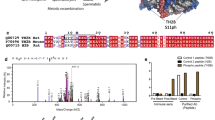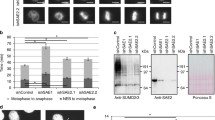Abstract
The XY body is a specialized chromatin territory that forms during meiotic prophase of spermatogenesis and comprises the transcriptionally repressed sex chromosomes. Remodeling of the XY chromatin is brought about by recruitment of specific proteins to the X and Y chromosomes during meiosis, and also by post-translational modifications of histones and other chromatin-associated proteins. Here, we demonstrate that SUMO, a small ubiquitin-related modifier protein that regulates a wide variety of nuclear functions in somatic cells, dramatically localizes to the XY body. SUMO was first detected in the XY body of early pachytene spermatocytes and gradually accumulated, reaching maximal levels there during the mid to late pachytene stages. Several known SUMO substrates, including PML and DAXX, were also found to accumulate in the XY body of mid to late stage pachytene spermatocytes. These same proteins localize to PML nuclear bodies of somatic interphase nuclei. Together, these findings indicate a role for SUMO modification in regulating the structure and function of the XY body and reveal molecular similarities between the XY body and PML nuclear bodies.








Similar content being viewed by others
References
Apionishev S, Malhotra D, Raghavachari S, Tanda S, Rasooly RS (2001) The Drosophila UBC9 homologue lesswright mediates the disjunction of homologues in meiosis, I. Genes Cells 6:215–224
Azuma Y, Arnaoutov A, Dasso M (2003) SUMO-2/3 regulates topoisomerase II in mitosis. J Cell Biol 163:477–487
Bachant J, Alcasabas A, Blat Y, Kleckner N, Elledge SJ (2002) The SUMO-1 isopeptidase Smt4 is linked to centromeric cohesion through SUMO-1 modification of DNA topoisomerase, II. Mol Cell 9:1169–1182
Biggins S, Bhalla N, Chang A, Smith DL, Murray AW (2001) Genes involved in sister chromatid separation and segregation in the budding yeast Saccharomyces cerevisiae. Genetics 159:453–470
van Brabant AJ, Stan R, Ellis NA (2000) DNA helicases, genomic instability, and human genetic disease. Annu Rev Genomics Hum Genet 1:409–459
Cobb J, Handel MA (1998) Dynamics of meiotic prophase I during spermatogenesis: from pairing to division. Semin Cell Dev Biol 9:445–450
Cobb J, Cargile B, Handel MA (1999) Acquisition of competence to condense metaphase I chromosomes during spermatogenesis. Dev Biol 205:49–64
Cohen PE, Pollard JW (2001) Regulation of meiotic recombination and prophase I progression in mammals. Bioessays 23:996–1009
Eaker S, Pyle A, Cobb J, Handel MA (2001) Evidence for meiotic spindle checkpoint from analysis of spermatocytes from Robertsonian-chromosome heterozygous mice. J Cell Sci 114:2953–2965
Eijpe M, Offenberg H, Goedecke W, Heyting C (2000) Localisation of RAD50 and MRE11 in spermatocyte nuclei of mouse and rat. Chromosoma 109:123–132
Fernandez-Capetillo O, Mahadevaiah SK, Celeste A, Romanienko PJ, Camerini-Otero RD, Bonner WM, Manova K, Burgoyne P, Nussenzweig A (2003) H2AX is required for chromatin remodeling and inactivation of sex chromosomes in male mouse meiosis. Dev Cell 4:497–508
Girdwood D, Bumpass D, Vaughan OA, Thain A, Anderson LA, Snowden AW, Garcia-Wilson E, Perkins ND, Hay RT (2003) P300 transcriptional repression is mediated by SUMO modification. Mol Cell 11:1043–1054
Gostissa M, Hengstermann A, Fogal V, Sandy P, Schwarz SE, Scheffner M, Del Sal G (1999) Activation of p53 by conjugation to the ubiquitin-like protein SUMO-1. EMBO J 18:6462–6471
Handel MA (2004) The XY body: a specialized meiotic chromatin domain. Exp Cell Res 296:57–63
Hari KL, Cook KR, Karpen GH (2001) The Drosophila Su(var)2–10 locus regulates chromosome structure and function and encodes a member of the PIAS protein family. Genes Dev 15:1334–1348
Hoege C, Pfander B, Moldovan GL, Pyrowolakis G, Jentsch S (2002) RAD6-dependent DNA repair is linked to modification of PCNA by ubiquitin and SUMO. Nature 419:135–141
Hoyer-Fender S (2003) Molecular aspects of XY body formation. Cytogenet Genome Res 103:245–255
Inselman A, Eaker S, Handel MA (2003) Temporal expression of cell cycle-related proteins during spermatogenesis: establishing a timeline for onset of the meiotic divisions. Cytogenet Genome Res 103:277–284
Ishov AM, Sotnikov AG, Negorev D, Vladimirova OV, Neff N, Kamitani T, Yeh ET, Strauss JF 3, Maul GG (1999) PML is critical for ND10 formation and recruits the PML-interacting protein daxx to this nuclear structure when modified by SUMO-1. J Cell Biol 147:221–234
Jang MS, Ryu SW, Kim E (2002) Modification of Daxx by small ubiquitin-related modifier-1. Biochem Biophys Res Commun 295:495–500
Kagey MH, Melhuish TA, Wotton D (2003) The polycomb protein Pc2 is a SUMO E3. Cell 113:127–137
Kawabe Y, Seki M, Seki T, Wang WS, Imamura O, Furuichi Y, Saitoh H, Enomoto T (2000) Covalent modification of the Werner’s syndrome gene product with the ubiquitin-related protein, SUMO-1. J Biol Chem 275:20963–20966
Kovalenko OV, Plug AW, Haaf T, Gonda DK, Ashley T, Ward DC, Radding CM, Golub EI (1996) Mammalian ubiquitin-conjugating enzyme Ubc9 interacts with Rad51 recombination protein and localizes in synaptonemal complexes. Proc Natl Acad Sci USA 93:2958–2963
Kralewski M, Novello A, Benavente R (1997) A novel Mr 77,000 protein of the XY body of mammalian spermatocytes: its localization in normal animals and in Searle’s translocation carriers. Chromosoma 106:160–167
Li SJ, Hochstrasser M (1999) A new protease required for cell-cycle progression in yeast. Nature 398:246–251
Li H, Leo C, Zhu J, Wu X, O’Neil J, Park EJ, Chen JD (2000a) Sequestration and inhibition of Daxx-mediated transcriptional repression by PML. Mol Cell Biol 20:1784–1796
Li W, Hesabi B, Babbo A, Pacione C, Liu J, Chen DJ, Nickoloff JA, Shen Z (2000b) Regulation of double-strand break-induced mammalian homologous recombination by UBL1, a RAD51-interacting protein. Nucleic Acids Res 28:1145–1153
Lombard DB, Guarente L (2000) Nijmegen breakage syndrome disease protein and MRE11 at PML nuclear bodies and meiotic telomeres. Cancer Res 60:2331–2334
Mahadevaiah SK, Turner JM, Baudat F, Rogakou EP, de Boer P, Blanco-Rodriguez J, Jasin M, Keeney S, Bonner WM, Burgoyne PS (2001) Recombinational DNA double-strand breaks in mice precede synapsis. Nat Genet 27:271–276
Mao Y, Desai SD, Liu LF (2000a) SUMO-1 conjugation to human DNA topoisomerase II isozymes. J Biol Chem 275:26066–26073
Mao Y, Sun M, Desai SD, Liu LF (2000b) SUMO-1 conjugation to topoisomerase. I. A possible repair response to topoisomerase-mediated DNA damage. Proc Natl Acad Sci USA 97:4046–4051
Matunis MJ, Coutavas E, Blobel G (1996) A novel ubiquitin-like modification modulates the partitioning of the Ran-GTPase-activating protein RanGAP1 between the cytosol and the nuclear pore complex. J Cell Biol 135:1457–1470
Maul GG, Everett RD (1994) The nuclear location of PML, a cellular member of the C3HC4 zinc-binding domain protein family, is rearranged during herpes simplex virus infection by the C3HC4 viral protein ICP0. J Gen Virol 75:1223–1233
McKee BD, Handel MA (1993) Sex chromosomes, recombination, and chromatin conformation. Chromosoma 102:71–80
Melchior F (2000) SUMO—nonclassical ubiquitin. Annu Rev Cell Dev Biol 16:591–626
Metzler-Guillemain C, Luciani J, Depetris D, Guichaoua MR, Mattei MG (2003) HP1beta and HP1gamma, but not HP1alpha, decorate the entire XY body during human male meiosis. Chromosome Res 11:73–81
Muller S, Matunis MJ, Dejean A (1998) Conjugation with the ubiquitin-related modifier SUMO-1 regulates the partitioning of PML within the nucleus. EMBO J 17:61–70
Muller S, Berger M, Lehembre F, Seeler JS, Haupt Y, Dejean A (2000) c-Jun and p53 activity is modulated by SUMO-1 modification. J Biol Chem 275:13321–13329
Muller S, Ledl A, Schmidt D (2004) SUMO: a regulator of gene expression and genome integrity. Oncogene 23:1998–2008
Pluta AF, Earnshaw WC, Goldberg IG (1998) Interphase-specific association of intrinsic centromere protein CENP-C with HDaxx, a death domain-binding protein implicated in Fas-mediated cell death. J Cell Sci 111:2029–2041
Richler C, Dhara SK, Wahrman J (2000) Histone macroH2A1.2 is concentrated in the XY compartment of mammalian male meiotic nuclei. Cytogenet Cell Genet 89:118–120
Rodriguez MS, Desterro JM, Lain S, Midgley CA, Lane DP, Hay RT (1999) SUMO-1 modification activates the transcriptional response of p53. EMBO J 18:6455–6461
Roeder GS, Bailis JM (2000) The pachytene checkpoint. Trends Genet 16:395–403
Seeler JS, Dejean A (1999) The PML nuclear bodies: actors or extras? Curr Opin Genet Dev 9:362–367
Seeler JS, Dejean A (2003) Nuclear and unclear functions of SUMO. Nat Rev Mol Cell Biol 4:690–699
Seeler JS, Marchio A, Sitterlin D, Transy C, Dejean A (1998) Interaction of SP100 with HP1 proteins: a link between the promyelocytic leukemia-associated nuclear bodies and the chromatin compartment. Proc Natl Acad Sci USA 95:7316–7321
Shaper NL, Wright WW, Shaper JH (1990) Murine beta 1,4-galactosyltransferase: both the amounts and structure of the mRNA are regulated during spermatogenesis. Proc Natl Acad Sci USA 87:791–795
Shen Z, Pardington-Purtymun PE, Comeaux JC, Moyzis RK, Chen DJ (1996) UBL1, a human ubiquitin-like protein associating with human RAD51/RAD52 proteins. Genomics 36:271–279
Shiio Y, Eisenman RN (2003) Histone sumoylation is associated with transcriptional repression. Proc Natl Acad Sci USA 100:13225–13230
Show MD, Folmer JS, Anway MD, Zirkin BR (2004) Testicular expression and distribution of the rat bcl2 modifying factor in response to reduced intratesticular testosterone. Biol Reprod 70:1153–1161
Solari AJ (1974) The behavior of the XY pair in mammals. Int Rev Cytol 38:273–317
Stead K, Aguilar C, Hartman T, Drexel M, Meluh P, Guacci V (2003) Pds5p regulates the maintenance of sister chromatid cohesion and is sumoylated to promote the dissolution of cohesion. J Cell Biol 163:729–741
Stelter P, Ulrich HD (2003) Control of spontaneous and damage-induced mutagenesis by SUMO and ubiquitin conjugation. Nature 425:188–191
Strunnikov AV, Aravind L, Koonin EV (2001) Saccharomyces cerevisiae SMT4 encodes an evolutionarily conserved protease with a role in chromosome condensation regulation. Genetics 158:95–107
Suzuki H, Seki M, Kobayashi T, Kawabe Y, Kaneko H, Kondo N, Harata M, Mizuno S, Masuko T, Enomoto T (2001) The N-terminal internal region of BLM is required for the formation of dots/rod-like structures which are associated with SUMO-1. Biochem Biophys Res Commun 286:322–327
Tanaka K, Nishide J, Okazaki K, Kato H, Niwa O, Nakagawa T, Matsuda H, Kawamukai M, Murakami Y (1999) Characterization of a fission yeast SUMO-1 homologue, pmt3p, required for multiple nuclear events, including the control of telomere length and chromosome segregation. Mol Cell Biol 19:8660–8672
Tarsounas M, Moens PB (2001) Checkpoint and DNA-repair proteins are associated with the cores of mammalian meiotic chromosomes. Curr Top Dev Biol 51:109–134
Tarsounas M, Pearlman RE, Gasser PJ, Park MS, Moens PB (1997) Protein-protein interactions in the synaptonemal complex. Mol Biol Cell 8:1405–1414
Walpita D, Plug AW, Neff NF, German J, Ashley T (1999) Bloom’s syndrome protein, BLM, colocalizes with replication protein A in meiotic prophase nuclei of mammalian spermatocytes. Proc Natl Acad Sci USA 96:5622–5627
Wiltshire T, Park C, Caldwell KA, Handel MA (1995) Induced premature G2/M-phase transition in pachytene spermatocytes includes events unique to meiosis. Dev Biol 169:557–567
Yan W, Santti H, Janne OA, Palvimo JJ, Toppari J (2003) Expression of the E3 SUMO-1 ligases PIASx and PIAS1 during spermatogenesis in the rat. Gene Expr Patterns 3:301–308
Yang SH, Sharrocks AD (2004) SUMO promotes HDAC-mediated transcriptional repression. Mol Cell 13:611–617
Zhong S, Hu P, Ye TZ, Stan R, Ellis NA, Pandolfi PP (1999) A role for PML and the nuclear body in genomic stability. Oncogene 18:7941–7947
Zhong S, Muller S, Ronchetti S, Freemont PS, Dejean A, Pandolfi PP (2000a) Role of SUMO-1-modified PML in nuclear body formation. Blood 95:2748–2752
Zhong S, Salomoni P, Pandolfi PP (2000b) The transcriptional role of PML and the nuclear body. Nat Cell Biol 2:E85–E90
Acknowledgements
We thank Dr. Bill Wright for assistance in rat germ cell purification and Janet Folmer for assistance in preparing polyester wax testis sections. We also gratefully acknowledge Drs. Anne Pluta and Gerd Maul for their generosity in sharing antibody reagents and Dr. Pier Paolo Pandolfi for providing PML (−/−) mice for this study. This work was supported by grants from the National Institutes of Health awarded to M.J.M. (R01 GM60980) and to M.A.H. (R01 HD33816).
Author information
Authors and Affiliations
Corresponding author
Additional information
Communicated by E.A. Nigg
Rights and permissions
About this article
Cite this article
Rogers, R.S., Inselman, A., Handel, M.A. et al. SUMO modified proteins localize to the XY body of pachytene spermatocytes. Chromosoma 113, 233–243 (2004). https://doi.org/10.1007/s00412-004-0311-7
Received:
Revised:
Accepted:
Published:
Issue Date:
DOI: https://doi.org/10.1007/s00412-004-0311-7




